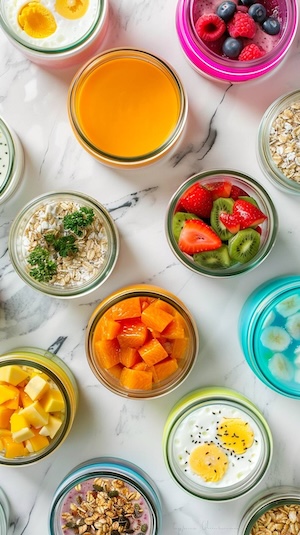PCOS for Picky Eaters: 30 Simple Meal Ideas
Discover 30 simple pcos meals for picky eaters that help manage symptoms. Easy pcos meals picky eaters will love, with practical tips and hormone-balancing ingredients.
This recipe includes superfoods such as:
Transform your health with tailored 7-day meal plans designed specifically for PCOS management. Just $7/month or $59/year.
Get it now →2 1/2 cups all-purpose flour, plus extra for dusting
2 teaspoons sugar
1 teaspoon salt
1/2 cup shortening
1 stick cold unsalted butter, cut into 1/4-inch dice
1 cup shredded white or yellow Cheddar, cold
1 teaspoon apple cider vinegar
3 to 4 tablespoons ice water
1 large egg
For the crust: Put the flour, sugar and salt in the bowl of a food processor. Pulse a couple of times to mix. Add the shortening and pulse to combine. Add the butter and pulse until the mixture is coarse and a few pieces of butter are still visible. Add the cheese and pulse just to combine. Add the apple cider vinegar and ice water. Pulse until the dough just begins to come together; it should look moist but still crumbly and not yet a complete ball. Turn the dough out onto a piece of plastic wrap and quickly form into a ball. Divide into 2 disks, one slightly larger than the other, wrap in plastic and refrigerate 1 hour or overnight. The less you work the dough the flakier it will be.
For the filling: Melt the butter in a large skillet over medium heat. Once melted, add the apples (if the apples cannot sit in one even layer, use 2 medium saute pans to cook the apples in batches). Add the sugar, lemon zest, lemon juice, cinnamon, nutmeg and salt. Continue cooking over medium heat until the apples release their liquid and it begins to boil, 12 to 15 minutes. The apples will be tender but will not lose their shape. Once the apples are tender, add the flour and cook until the liquid has thickened and coats the back of a spoon, about 1 minute longer. Remove the apples to a baking sheet and spread out in an even layer to cool to room temperature, about 1 hour.
Preheat the oven to 425 degrees F. Place a baking sheet in the oven while preheating so it will be hot by the time the pie goes into the oven.
Roll the larger disk of dough on a lightly floured surface to about 12 inches in diameter and 1/8-inch thick, to fit a 9 1/2-inch deep-dish pie plate. Roll the dough onto your rolling pin and then unroll it over your pie plate. Trim the excess dough to 1/2-inch, and do not crimp the edges. Place the cooled filling in the pie plate, mounding at the center.
Roll the smaller disk of dough on a lightly floured surface to 1/8-inch thick and 10 inches in diameter and place on top of the filling. Fold the edges under, and decoratively crimp the edges. Cut slits in the top crust to allow steam to escape. Whisk the egg with 1 teaspoon water and brush the top of the pie.
Place the pie on the preheated baking sheet and bake for 10 minutes. Decrease the temperature to 350 degrees F and continue baking until the top crust is golden brown and crisp to the touch and the bottom crust is browned, 50 to 60 minutes. Cool to room temperature and serve.
Cook's Note: Use a cave-aged Cheddar for a stronger cheddar taste.

You know the drill: Alarm goes off. You hit snooze. Rush around frantically. Skip breakfast AGAIN because there's no time. By 10am, you're hangry, your blood sugar is all over the place, and your PCOS symptoms are already acting up.
Sound familiar?
Finally – a meal prep system designed specifically for women with PCOS who refuse to let chaotic mornings derail their health goals.
In just ONE hour on Sunday, you can transform your entire week:
"I went from skipping breakfast 4 days a week to having delicious, hormone-supporting meals ready every morning. My energy is more stable and my cravings have disappeared!"
– Sarah M.
Stop letting chaotic mornings control your health.
Get your hormone-happy mornings starting this Sunday.
→ Get Your 60-Minute Solution Now
Transform your health with tailored 7-day meal plans designed specifically for PCOS management. Just $7/month or $59/year.
Get it now →Serving Size: 0
| Amount Per ONE Serving | ||
|---|---|---|
| Calories 0 kcal | ||
| Fat 0 g | ||
| Carbohydrate 0 g | ||
| Protein 0 g | ||
💡 Introducing the 10/10 PCOS Solution:
Ten Delicious Crockpot Recipes that take just 10 minutes to prep!
Say goodbye to hours in the kitchen and hello to clean, PCOS-friendly meals made effortlessly.
👉 Click here to grab your 10/10 PCOS Solution today! Try The 10/10 PCOS Solution: Ten Crockpot Recipes That Take Just Ten Minutes to Prep
Managing PCOS can be challenging, but you don't have to do it alone. Join our supportive community to connect with others who understand what you're going through, share tips, and get encouragement. Here's how you can get involved:
Subscribe to our Newsletter: Receive PCOS-friendly recipes, tips, research updates, and more delivered straight to your inbox. Stay informed and empowered with the latest information and support.
Join our Telegram Channel: Stay updated with the latest tips and advice on managing PCOS.
Follow PCOS Meal Planner on Facebook: Engage with our community, participate in discussions, and get support from others.
Break the cycle with the PCOS Meal Planner - your personalized guide to eating better, feeling better, and managing PCOS symptoms. Take control today!

Forget the frustrating cycle of weight loss attempts, endless medications, and living in discomfort. Introducing the PCOS Meal Planner. A meal planning guide that goes beyond temporary fixes to offer a comprehensive strategy, empowering you to ignite a transformation towards lasting health and happiness. Step into a world where you control your PCOS, not the other way around.
Unlock Your PCOS Freedom Now.
Discover 30 simple pcos meals for picky eaters that help manage symptoms. Easy pcos meals picky eaters will love, with practical tips and hormone-balancing ingredients.
Discover 15 delicious overnight oats for PCOS recipes that help balance hormones and manage symptoms. Easy, nutritious breakfast ideas perfect for women with PCOS.
Discover the best cereal for PCOS with our expert rankings. Compare brands, check ingredients, and find PCOS friendly cereal that supports hormonal balance.
Learn how to transition away from fruit when starting a ketogenic diet for PCOS. Discover gradual strategies, fruit alternatives, and practical tips for success.
Discover 5 delicious PCOS banana bread recipes with low-glycemic ingredients. Learn how to make hormone-friendly banana bread that supports blood sugar balance.
Creatine for women with PCOS explained simply. Learn safety, benefits, hormone effects, tips, and how creatine may support PCOS symptoms naturally.
Complete PCOS diet plan with foods to eat, foods to avoid, meal timing, and real results. Learn the science-backed approach to managing PCOS through diet, with 7-day meal plan, grocery list, and step-by-step implementation guide. Based on clinical research and real patient outcomes.
Complete guide to ordering at Wendy's with PCOS. Discover the best protein-focused meals, what to skip, and how to customize orders to keep blood sugar stable. Learn which burgers, salads, and sides work for PCOS, plus complete macros for every menu item and smart swaps to avoid insulin spikes.
Complete guide to ordering at Burger King with PCOS. Discover the best protein-focused meals, what to skip, and how to customize orders to keep blood sugar stable. Learn which burgers, salads, and sides work for PCOS, plus complete macros for every menu item and smart swaps to avoid insulin spikes.